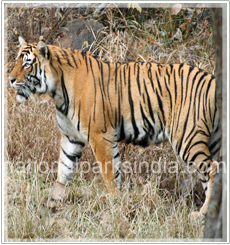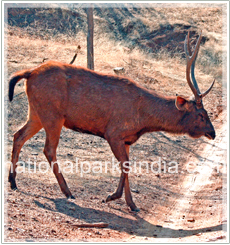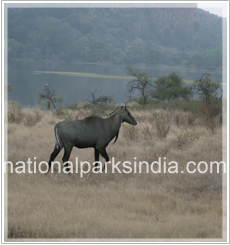24,Aurobindo
Sri Aurobindo Marg Adhchini
National Parks India
Wildlife Trip Report
WITH WILDLIFEINDIA CO UK (PART OF INDIAN NATURE TOURS)
We first visited RanthamboreNational Park to go in search of Panthera Tigris Tigris ( Ptt ) . We went beginning of Jun to mid June to both parks before both parks closed for the rainy season to catch our first glimpse of this species in the wild. June 2nd to Jun 6th was spent at Ranthamboremainly ,and between Jun 7 to Jun 10 in Bandhavgarh.
PART 1 : RanthamboreTrip June 2nd to June 6th

Ranthambore(Jun 2nd-Jun 6th)
The hotel we stayed at with Wildlife India Co Uk (Indian Nature Tours) and which comes highly
recommended is the RanthamboreRegency hotel. We arrived at the hotel on the evening of Jun 3rd. In all we had taken 5 jungle excursions in a gypsy or jeep in all during our stay at Sawai Modhupur, Ranthambore, covering as many routes as possible in this period giving a better chance of seeing a Bengal tiger. We were lucky enough to travel with Manoj Sharma, Company Principle of Indian Nature Tours and wild life expert for last twenty years or so. The new website of Indian Nature Tours is WWW.WILDLIFEINDIA.CO.UK which can be found on the useful links page. It is due to him that we saw as many as up to 7-9 different Bengal tigers, of course he was our interpreter as well as guide throughout the trip offering first class service.
NUMBERS OF PASSENGERS IN GYPSY THROUGHOUT TRIP TO Ranthambore:
4 (DRIVER, MYSELF, MANOJ, FOREST GUARD/ GUIDE) FIRST JUNGLE EXCURSION (June
3rd) MORNING
1.Departed from the regency 05.45, arrived at 06.00 at National Park entrance.
Every time we visited the park there were many salesmen, selling memorabilia
and like Ranthamborepark guides, pens, hats, books, playing cards etc.There
was also a list of rules to abide by when visiting the Park , some are don't
step out from jeep , do not tease the animals and to pay 200 rupees for use of video camera in the
park, cameras are free whilst professional photography is anything between 3000-5000
rupees, these are only some of them I don't want to go into to much detail though.
Every day pilgrim's could be seen visiting the Ganesh temple at the Park.
On most days the first subject matter would be Tiger, so once we entered the park we always asked the guide or forest guard with us questions like, when was the last sighting of a Tiger, if any recent Pugmarks in the area to give us indication of where tiger or tigers are located, which one, how many, perhaps calls were heard recently from tiger's prey.
Any way back to our drive, we had taken route 2 of 7, which are possible to
take at the park. On this route we passed a waterhole with a sambar Deer drinking
the water. Fifteen minutes later returning from the forests guards home which
is half way point to the route, we suddenly heard a langur call (coughing sound)
and sambar call (honking call-highly possible from the same sambar we saw quarter
of an hour earlier), simultaneously these calls were made, clearly this meant
that a tiger or tigers were nearby. The tiger's prey in most cases always makes
an alarm/warning call warning others
in the jungle that his predator is about part of the jungle system. It was here
that Save India's Tigers had had its first ever sighting of Panthera Tigris
Tigris in the wild totally -different complexion, beauty to those found in captivity.
There was more expression in their face, more peace and tranquility about them
here in its natural habitat. A shot was taken of our first sighting on Ptt in
India page.
 The tigeress after seeing the approaching jeeps went into the waterhole to protect
her one-year old cub, snarled at us a little, but seemed to enjoy the coolness
of the lake. Three to four minutes later the tigeress was first to come out from
the waterhole, We could still hear constantly langur calls throughout this sighting.
The animals, which made the calls as well as the 4 jeeps carrying tourists i
felt were responsible for the departure of both tigeress and cub back into deep
jungle. While the tigeress was making its move we could hear the cub calling
out to its mother and eventually they were together once again. All jeeps at
this moment followed them both the whole time as they left the waterhole, with
green backsides, slowly strolling on the roads and into the other side of the
jungle area of the park. We were over the moon to have seen 2 tigers together
in one location on our first day. The tigeress main concern from the first moment
we saw the tigers was the cub, which was her pride and joy, always on the look
out for dominant male tigers which may kill her cubs, Some of the shots we took
of our trip to Ranthamboreand Bandhavgarh can be seen throughout the website.
The tigeress after seeing the approaching jeeps went into the waterhole to protect
her one-year old cub, snarled at us a little, but seemed to enjoy the coolness
of the lake. Three to four minutes later the tigeress was first to come out from
the waterhole, We could still hear constantly langur calls throughout this sighting.
The animals, which made the calls as well as the 4 jeeps carrying tourists i
felt were responsible for the departure of both tigeress and cub back into deep
jungle. While the tigeress was making its move we could hear the cub calling
out to its mother and eventually they were together once again. All jeeps at
this moment followed them both the whole time as they left the waterhole, with
green backsides, slowly strolling on the roads and into the other side of the
jungle area of the park. We were over the moon to have seen 2 tigers together
in one location on our first day. The tigeress main concern from the first moment
we saw the tigers was the cub, which was her pride and joy, always on the look
out for dominant male tigers which may kill her cubs, Some of the shots we took
of our trip to Ranthamboreand Bandhavgarh can be seen throughout the website.
Departed park around 08.55
JUNGLE EXCURSION 2 (Jun 3rd) AFTERNOON
1.Arrive 15.45 at the park. This time we once again had taken route.
2. On this afternoon/evening drive sighted our first tiger which was a tiger
cub underneath one of the trees of the park taking shade from the scorching
sun. Unfortunately as it was under the shade and in a distance it wasn't clear
and there much activity going on there as it was taking an afternoon nap, alright
for some .This cub was a different cub to the one we saw in the morning and
believed to be of eight months old slightly younger. Around 17.15 soon before
our departure from the park a tigeress with its two cubs could be seen below
on much lower ground, besides some caves to the mountains. Even with binoculars
the sighting wasn't clear to the naked eye, it was only a call from langur which
lead us to the movement of these three tigers. The genders of both cubs to this
tigeress were not known, which i found bizarre, the park guides knew of the ages
of the tigers yet they did not know the genders. This could either be because
of poor management system or someone is not pulling their weight around which
was clear to me I don't mean to make accusations but i think all guides and
forest guards should at least have good knowledge on the parks tigers. Departure
at 18.15
Animals we have seen today:Sambhar
, nilgai (blue bull), chital (spotted deer),
and kingfisher, Bengal tigers, antelope, wild peacock (national bird of India),
langur monkey, jackal, wild boar.
JUNGLE EXCURSION 3 (Jun 4th) MORNING
1.Depart from Regency 05.45 arrive at park 06.00
 2.This morning we had taken both routes 1/2. Main highlights were Ranthambore
Fort and met some of the forest guards at entrance to the park. We noticed sloth
bear pugmarks via this route but yet no bear was spotted. 38 tigers have been
reported in the last tiger census prior to the one recently taken on 25th May
the report on recent tiger census in all parks will published later this year.
A count on its tigers is done annually according to what our guide told us.
There was a nilgai alarm call around 07.30 which informed us that tiger was
just in front of us. We noticed that the jeeps ahead of us on route had already
viewed a tigeress with cubs, but by the time we got there it was already too
late, they had disappeared into the forest. Later discovered more pugmarks of
her cubs. We were a little unfortunate not to have seen a tiger today, but tourists
can have many days without a sighting. Departure at 21.15
2.This morning we had taken both routes 1/2. Main highlights were Ranthambore
Fort and met some of the forest guards at entrance to the park. We noticed sloth
bear pugmarks via this route but yet no bear was spotted. 38 tigers have been
reported in the last tiger census prior to the one recently taken on 25th May
the report on recent tiger census in all parks will published later this year.
A count on its tigers is done annually according to what our guide told us.
There was a nilgai alarm call around 07.30 which informed us that tiger was
just in front of us. We noticed that the jeeps ahead of us on route had already
viewed a tigeress with cubs, but by the time we got there it was already too
late, they had disappeared into the forest. Later discovered more pugmarks of
her cubs. We were a little unfortunate not to have seen a tiger today, but tourists
can have many days without a sighting. Departure at 21.15
JUNGLE EXCURSION 4 (Jun 4th) AFTERNOON
1.Depart Regency at 15.30 arrive 15.45 park.
2.Today we took route number six/seven. During this time of year some parts
of the park are green in color whilst others are not simply because of the availability
of water in these areas have been low. Last time it properly rained here was
in November 2004. Many routes, which are in the park, were made during the raja
period. The highlights of this drive were that we visited the big lakes areas
mainly Padam and Rajbagh. It is here that tourists can see a whole array of
species like sambar, chital, crocodiles, stork, wild boar, and on many occasions
tiger has been seen here. One of the great valleys of the park isthe Makarda
Valley, during this dry season we could see most of the lakes were dried up
but padam was full of water, malik lake was totally dried up. Our guide for
the day told us about the 'lady of the lake' which is the tigeress of the lake
which has been seen a few times inside the palace on the first floor looking
down on the lake wondering it can have for its dinner, yet still out of sight
from most of its prey.
It was around 17.20 we saw a Bengal tigeress clearly with one of its cubs the
view of tigeress was great but not of the cub. It was the calls of sambar and
langur, which immediately gave us clue as to the tigeress whereabouts. It was
the same tigeress that we had seen yesterday but much nearer to our higher level
this time round. We passed a firewall, which was built in case of forest fires,
but i couldn't see how it could prevent other areas of the park. The forests trees like deciduous and banyan wood it is made from were very prone
to forest fires. For the last two days now we realized that this same tigeress
was seen sometimes alone or with its cubs in and round the same caves and around
the same time this is its territory it seems. The caves offer great shelter
from enemies' i.e dominant male tigers. I could tell that at the end of today
we were never going to see a male tiger in this park.
Departure 18.45
Animals seen today were: Nilgai, Bengal tigers, magpie, chinkara, langur monkey, squirrel, peacock, crocodiles, wild boar, stork, spur fowl, paradise flycatcher bird, butterfly, woodpeckers, chital herd, grey tits.
JUNGLE EXCURSION 5(Jun 5th)
 1.Depart 05.55 Regency arrival 06.15 park.
1.Depart 05.55 Regency arrival 06.15 park.
2.On this last drive of the park route 2 was taken. A few animals were seen but no tiger sighting on this morning's drive, there were some tiger pugmarks though which could have been made earlier in the morning. We visited once again a forest guard's home. The forest guard had told us of the many times he has seen tigers near his family and home but it didn't bother him to much as he knew the animals behavior very well. Here we had an opportunity to play and tease the chital outside their home, this was great fun and was the only time we could get out of our jeeps. The chital was very friendly towards us.
Animals seen today: Partridge, chital, sambar, wild boar, no tiger spotted,
monitor lizard, quails. Normally there are many birds seen in this park but
because of dry season many have migrated, Ranthamborewas presently dried out
trees and lakes not the best place for birds this time of year. Only a few green
trees were seen on our visit.
Ramsar Sites

India presently has 19 sites designated as Wetlands of International Importance with a surface area of 648,507 hectares.
Read More

Trip Report
2nd June To
10th June

 Indian Nature Tours 24,Aurobindo Apartments
Sri Aurobindo Marg
Adhchini,
New Delhi 110017
Indian Nature Tours 24,Aurobindo Apartments
Sri Aurobindo Marg
Adhchini,
New Delhi 110017
Ph: 91-11-65969433, 26967034, 26521768 Cell: 91-9810026819
Email:Trips@wildlifeindia.co.uk Website: www.wildlifeindia.co.uk
